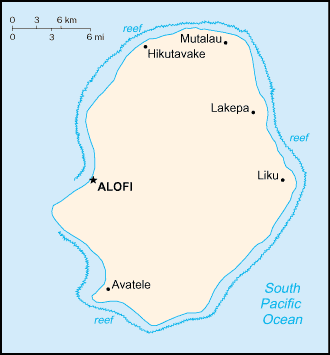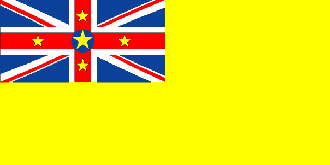
|
Country of Niue
Background:
Niue's remoteness, as well as cultural and linguistic differences
between its Polynesian inhabitants and those of the rest of the Cook Islands,
have caused it to be separately administered. The population of the island
continues to drop (from a peak of 5,200 in 1966 to 2,100 in 2000) with
substantial emigration to New Zealand.
Location:
Oceania, island in the South Pacific Ocean, east of Tonga.
Area: Total: 260 sq km.
Area - comparative: 1.5 times the size of Washington, DC.
Coastline: 64 km.
Climate and Terrain:
Tropical; modified by southeast trade winds.
Steep limestone cliffs along coast, central plateau.
Elevation extremes: Lowest point: Pacific Ocean 0 m highest point: unnamed
location near Mutalau settlement 68 m.
Natural resources: fish, arable land.
Land use: Arable land: 19%.
Geography - note: One of world's largest coral islands.
People:
Population: 2,124 (July 2001 est.).
Population growth rate: 0.5% (2001 est.).
Ethnic groups: Polynesian (with some 200 Europeans, Samoans, and Tongans).
Languages: Polynesian closely related to Tongan and Samoan, English.
Government:
Capital: Alofi. Self-governing in free association with New Zealand; Niue
fully responsible for internal affairs; New Zealand retains responsibility for
external affairs.
Government type: Self-governing parliamentary democracy.
Independence: on 19 October 1974, Niue became a self-governing parliamentary
government in free association with New Zealand.
Economy overview:
Government expenditures regularly exceed revenues, and the
shortfall is made up by critically needed grants from New Zealand that are used
to pay wages to public employees. Niue has cut government expenditures by
reducing the public service by almost half. The agricultural sector consists
mainly of subsistence gardening, although some cash crops are grown for export.
Industry consists primarily of small factories to process passion fruit, lime
oil, honey, and coconut cream. The sale of postage stamps to foreign collectors
is an important source of revenue. The island in recent years has suffered a
serious loss of population because of migration of Niueans to New Zealand.
Statistics:
Telephones - main lines in use: 376 (1991).
Telephones - mobile cellular: 0 (1991).
Single-line telephone system connects all villages on island. Radio broadcast stations: AM 1, FM 1, shortwave 0 (1998).
Radios: 1,000 (1997).
Television broadcast stations: 1 (1997).
Highways: total: 234 km paved: 86 km unpaved: 148 km (106 km of which is
access and plantation road) (2001).
Ports and harbors: none; offshore anchorage only.
Airports - with paved runways: total: 1, 1,524 to 2,437 m: 1 (2000 est.).
Return to Visiting Locations
|

